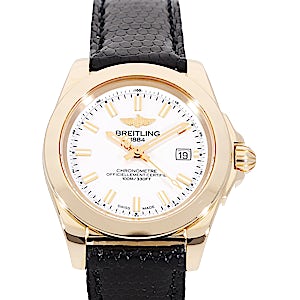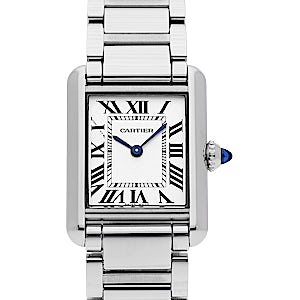Quartz Watches
Discover more about quartz watches
Quartz watches – electronic timepieces
Quartz watches have been on the rise for over 40 years: electronically-operated watches with quartz at their heart have been an integral part of the watch world since the 1970s. With unbeatable accuracy, low-level maintenance and comparatively low production costs, they have earned the right to exist alongside classic mechanical watches. In addition, being particularly quiet and light, they are perfect for everyday wear. For this reason, most well-known manufacturers have quartz watches for men and women in their ranges.
Popular quartz watch models
Owing to the great success of quartz watch movement technology, most watch manufacturers, including large traditional Swiss brands, have incorporated quartz watches into their portfolios. At CHRONEXT you will find quartz watches in gold, stainless steel and many other materials from brands such as Omega, Chopard, Patek Philippe, IWC and others.
In addition to its mechanical classics, the German luxury brand Glashütte offers a particularly large range of quartz watches for men and women. Of course, quartz timepieces don't have to sacrifice design despite their modern technology: Cartier, Jaeger-LeCoultre and other renowned manufacturers embellish their quartz models with striking and luxurious housings in the style of their respective 'maisons'. Owing to their lack of mechanics, quartz watches are usually much cheaper than the mechanical models from these luxury brands. The most popular models include the Hamilton Ventura, Chopard Happy Diamonds and quartz models from Swatch.
The discovery of a promising technology
Quartz watches experienced a triumphal march forward in the 1970s and 1980s: more and more manufacturers were switching to the new technology and customers were enjoying these high-precision models which also had the benefit of being particularly cheap to purchase.
The technology behind the quartz watch, however, has its origins in the 19th century: as early as 1880, French-born Pierre and Paul Curie found out that certain crystals such as quartz and tourmaline 'vibrate' when they come into contact with electrical voltage. In 1928, Adolf Scheibe and Udo Adelsberger - two German physicists - came up with the idea of using this phenomenon in watchmaking. The first watches driven in this way were a metre wide and the only thing they had in common with today's wristwatches was the technology. The two inventors made another important discovery: with the help of their precise timepieces, they found that the Earth's rotational speed varies over the course of a year.
The Munich-based electronics group Rohde & Schwarz recognised the potential of quartz technology early on: originally, large quartz timepieces were produced with electron tubes. The first portable quartz watch appeared in 1938.
The quartz crisis and market realignment
At the end of the 1960s, the Japanese company Seiko started producing the first commercial quartz watch. The Astron model and other inexpensive Japanese watches inundated the global watch market creating what is known today as the 'quartz crisis'. The watch industry was in a state of emergency: long-standing mechanical watches from traditional manufacturers couldn't keep up with quartz watches in terms of accuracy, power reserves and durability. They were also significantly more expensive than Japanese mass-produced watches.
The realignment of watch manufacturers
In the 1970s, many large Swiss and German watch manufacturers jumped on the quartz watch bandwagon, realigning themselves and advancing research into the field of quartz technology itself. It was in this way, that the first quartz movement, the caliber 21 with a vibrating motor saw the light of day. The traditional German company, Junghans was a pioneer in the field and in 1970 launched its own wristwatch with a quartz movement - the 'Astro Quartz'. In addition, the quartz movement also paved the way for an invention without which the watch market cannot be imagined today - the digital wristwatch. The first of its kind was a model from the American watch brand Hamilton. While digital Hamilton watches still required large amounts of electricity for the time display, manufacturers such as Longines were soon working on energy-saving models with liquid crystal displays (LCD).
Innovations and new developments
Developments in quartz watches advanced rapidly during the 70s and 80s. With each innovation, the watches became more robust, more powerful and - thanks to compact calibers - more slimline. As early as 1980, the 'Dinosaure' from Omega was only 1.46mm in depth.
Another milestone in the history of the quartz watch was the 7M22 caliber presented by Seiko in 1986. This caliber has a peculiarity: its innovative clockwork converts movement energy into electrical energy so generating the energy it needs itself. Known today as 'kinetic' technology, it is widely used in many areas.
Since the 1990s, many watch manufacturers have returned to the traditional craft of mechanical watchmaking. Nevertheless, quartz watches are now a firm part of most manufacturer's ranges and still represent maximum precision combined with relatively low prices.
How a quartz watch works
On quartz watches the frequency is no longer specified by a mechanical pendulum or balance wheel but by electronic pulses. These are passed on to the so-called watch quartz either by means of a battery, rechargeable battery or capacitor. The quartz, which is the same shape as a tuning fork, is set in motion and serves as the clockwork. To ensure an accurate time display, the oscillation frequency, which is normally 32768 Hertz, is reduced to one oscillation per second.
Electronically-operated quartz clocks can be manufactured with both analogue and digital time displays. The impulses of the quartz are either passed on to a stepper motor that controls the hands of the watch or to an LED or LCD display where the time is read in the form of digital numbers.
As the frequency of quartz watches is significantly higher than that of mechanical watches they are much more precise. They also retain their precision over a longer period of time than their mechanical predecessors: while these can deviate by up to six seconds per day, quartz watches only deviate by five to 10 seconds per month.
The maintenance of quartz watches
As quartz watches are operated electrically and are not based on mechanical components, they are comparatively robust and easy to maintain. With a battery-powered watch, the battery needs to be replaced occasionally. If the watch gets its energy from solar cells, battery replacement is not necessary. Despite the high precision of quartz watches, inaccuracies do occur over time so it is a good idea to regularly compare their time with more accurate clocks such as radio-controlled ones and adjust as necessary. By doing this, the watch will remain accurate. Also, in order to maintain the accuracy of quartz watches, they should be protected from extremes of temperature.























